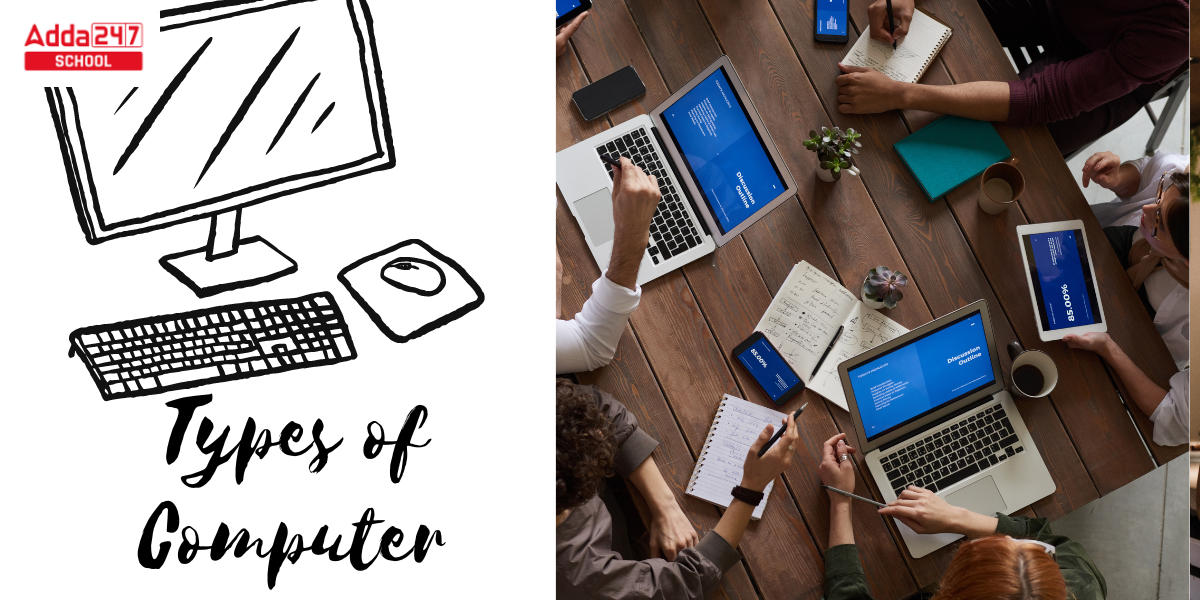Types of Computers: In the Digital Era, Computers are the integral part of our Human being. Nowadays we use computer in every aspect in or daily live activities starting from Medical science, security, calculation, and research and the lost is going on rater than only personal use. As a result, an increase in needs has resulted in an increase in demand. A single type of computer is into sufficient to fulfill all the needs. As a result, the technology is advanced, and different types of Computer are introduced for fulfilling the needs. In this article, we will gong discuss various types of computers, their applications and their Specialization.
Types of Computer
A computer is a device that converts data into usable information. It processes the input in accordance with the set of instructions supplied by the user and produces the intended output. The term computer is derived from the English word ‘Compute,’ which means “to calculate.” To solve. Based on the Requirements, Computers are being designed to perform efficiently. . There are various computer types based on computer size and data handling capabilities. All newly created computers have unique characteristics and designs. While some computers are fast and have great capacity, others are sluggish. Although there are many different types of computers, we can generally be divided into two categories depending on their size and data-handling skills. There are five different types of computers based on size, and three other types of computers based on how well they can handle data.
Type of Computer |
|
| Types of Computer Based on Size | Types of Computer-Based on Data Handling Capabilities |
|---|---|
| 1. Supercomputer | 1. Analogue Computer |
| 2. Mainframe computer | 2. Digital Computer |
| 3. Minicomputer | 3. Hybrid Computer |
| 4. Personal Computer (PC) | |
| 5. Workstation | |
Types of Computer Based on Data Handling Capabilities
There are Three different types of computers based on data Handling Capabilities. let’s know about a brief introduction of types of computer based on data handling
1. Analogue Computer
An analog computer is one that analyzes the issue at hand using the constantly changing elements of physical events.The processing of analog data is the sole purpose of analog computers. It is a form of continuously changing, continuous data that lacks discrete values. When consumers are unfamiliar with precise values for things like temperature, speed, current, and pressure, they employ these types of computers, which are very difficult to use.
The best thing about this computer is, Without converting the information into a numerical value, these computers can immediately accept data from the devices. The results are shown on a dial or scale after they continually measure changes in physical amount. Examples of this type d of computer are mercury thermometers and speedometers.

2. Digital Computer
This types of computer is used to execute calculations and logical operations at a very high speed. It accepts data in the form of binary integers (0 and 1) or digits as input and processes it using programmes and outputs the results. Users of digital computers can more readily update the system with the newest features. It is also capable of easily retrieving a vast amount of information stored. Modern digital computers include all laptops, desktops, and cellphones that we use at home or at the office.

3. Hybrid Computer
Computers that combine elements of both digital and analog computing are called hybrid computers. These types of Computer have a speed that is comparable to analog computers and are exactly like digital computers in terms of precision and memory. The ability to process both discrete and continuous data is a feature of hybrid computers. Before processing, it receives analog signals and converts them to digital form. As a result, it is frequently employed in specialized applications that process both analog and digital data. For instance, a hybrid Computer is utilized in gas pumps to translate fuel flow measurements into amount and cost.

Types of Computer Based on size with Examples
As per the working complexity the size of Computer also differ. On the basis of size, There are 5 types of computer can be found. Below is a detailed breakdown of each of the five different types of computers based on their size.
1. Supercomputer
As the Name suggests, Supercomputersare the largest and fastest computers among all types of computers. Supercomputers are specifically built to process large volumes of data and perform large amounts of computation quickly. Roger Cray created the first supercomputer in 1976.Its thousands of interconnected processors allow it to process trillions of instructions in a matter of seconds. This includes weather forecasts, healthcare equipment, and nuclear research, among other things. Supercomputers are excellent for applications that need a tremendous amount of computing or involve very big databases.

2. Mainframe computer
Mainframe is a multiprocessing computer that are built to support hundreds or thousands of users at the same time. This types of computer has two or more CPUs and may accommodate many people concurrently across its many terminals. Managing client statistics, census data, and other large amounts of data on a single device are among the main functions of this kind. In places like institutions or departments, minicomputers are utilized for a variety of tasks including billing, accounting, trading firms, inventory management, etc.

3. Minicomputer
Minicomputer is a types of computer that falls between a microcomputer and a mainframe computer. A minicomputer is a mid-range computer that is intermediate in size, power, speed, storage capacity, and so on. This computer has two CPUs and can support up to 200 people at once. They are extensively utilized in institutes and departments for accounting-related duties.

4. Personal Computer (PC)
A personal computer, often known as a microcomputer, is a general-purpose computer built for individual use. Personal computers are low-cost computers that have a microprocessor as the central processing unit, memory, storage space, an input unit, and an output device. These computers have little circuitry mounted on a single circuit board. Desktop, laptop, and more examples are available.

5. Workstation
A workstation computer is a single-user computer that is typically employed to do a specific task accurately for technical or scientific applications. Workstations include a fast microprocessor, a big quantity of RAM, network capability, a graphical user interface, and a high-speed graphics adapter.Workstation computers are capable of doing heavy-duty tasks. Animation, CAD, audio and video editing, professional gaming, and so on. Apple PowerBook G4, MIPS CPU, SPARC CPU, and other similar computers are examples of this types of computer.










 CUET UG Final Answer Key 2025 Revised, D...
CUET UG Final Answer Key 2025 Revised, D...
 DU Cut off 2025, Delhi University Expect...
DU Cut off 2025, Delhi University Expect...
 OUAT Result 2025 OUT @ouat.nic.in: Check...
OUAT Result 2025 OUT @ouat.nic.in: Check...

